Early Forms of Imprisonment
As a means of restriction of freedom, prisons existed in ancient Mesopotamia, China, India, Persia, Egypt, Greece, and Rome and in the medieval period, when it was used to restrain the freedom of movement of debtors, persons waiting for trial or execution of penalty – deportation, death penalty or fine.
It is believed that the first penitentiary was established in 1553 in Bridewell Castle in London. It served for the placement of persons who threatened public order and safety and later perpetrators of criminal offences as well. In Amsterdam, a juvenile prison was established in 1595, whereas a prison for women was built in 1596. They were considered role models for other similar institutions in developed European countries.
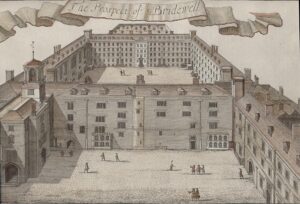
Photography 1. Johannes Kip (1652/3-1722) The Prospects of Bridewell
Source: https://www.rct.uk/collection/702230/the-prospect-of-bridewell
The oldest method of prison sentence enforcement, present until the beginning of the prison reform movement at the end of the 18th and the beginning of the 19th century, was based upon the placement of convicts in shared premises, regardless of their age, gender, duration of punishment, the gravity of the committed offence, personal characteristics and health.
Prison Reforms
Prison systems’ reform was encouraged by the movement for the rights of convicts, led by John Howard, who highlighted inhumane conditions in joint prisons at the end of the 18th century in his book “The State of the Prisons In England and Wales” and advocated for the reform of the penal system. Howard’s ideas spread across the world, especially when it comes to moral education, working engagement and separation of convicts in isolated cells. Howard’s follower, Mirabeau, also supported the separation of convicts in isolated cells, as well as their awarding and conditional release, whereas Bentham proposed a specific architectural solution for prisons, known as the “star system” or “panopticon”. The aim of the panopticon was to provide control of convicted persons from one place.
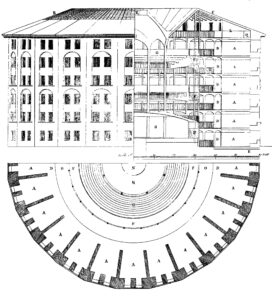
Photography 2. The scheme of prison according to the model of Bentham’s Panopticon
Source: https://oll.libertyfund.org/page/images-of-liberty-and-power-jeremy-bentham-panopticon
One of the first prisons of this type was Millbank Prison in Westminster in London, which functioned between 1816 and 1890. Bentham also supported the obligatory work of convicts and their professional education. The reforms of prison systems in America and Europe started from these ideas and critiques of joint prisons.
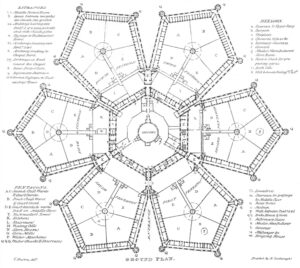
Photography 3. Millbank Priosn Plan (1828)
Source: https://en.wikipedia.org/wiki/File:Millbank_Prison_Plan.jpg
Cell Prison System (Pennsylvanian or Philadelphian)
The cell prison system is considered as the first legally regulated system of the enforcement of imprisonment punishment, and it is based upon the ideas of Howard, Bentham and Mirabeau that convicts should dwell in separated rooms, at least during the night.
The Pennsylvanian or Philadelphian system was grounded on Howard’s ideas and moral principles of the Quakers – members of a religious Christian movement supporting philanthropic efforts such as the abolition of slavery, prison reform, peace and social justice. They believed that humans are good by nature and that the most severe offenders can experience moral rebirth through labour and contemplation, dwelling in solitary confinement. In accordance with these convictions, the state of Pennsylvania established the first prison with separate cells in 1790 in Philadelphia – Walnut Street Prison.
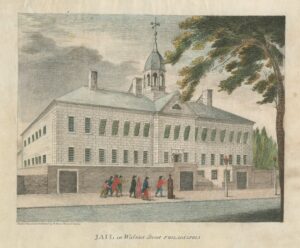
Photography 4. Walnut Street Prison (graphic)
Source: https://digital.librarycompany.org/islandora/object/Islandora%3A13356
Auburn system (the system of silence) represents an effort to mitigate the disadvantages of the Pennsylvanian system, which led to mental health issues and suicides among convicts due to loneliness and isolation. The first prison in which convicts were sent to solitary confinement during the night and worked together during the day was established in Auburn in the state of New York in the 1920s. During joint labour, the convicts had to wear hoods or hats with a large brim, designed to prevent them from recognising and communicating with each other. In this system, labour is treated as a means of re-education and professional education.
After the establishment of the cell system in America, the idea of these prisons rapidly expanded in Europe – Belgium, France, Hungary, Prussia, Sweden and Denmark.
Progressive Systems
Prison reform continued in the first half of the 19th century when the idea to introduce the possibility of progress in convict status emerged. Consequently, English and Irish progressive, Maconochie’s and classification system were applied.
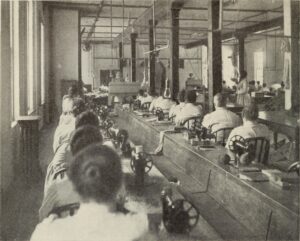
Photography 5. Workshop in Auburn Prison (1890)
Source: https://archive.org/details/reviewofreviewsw44newy/page/80/mode/1up?view=theater
English progressive system represents a combination of cell systems with the benefits of progressive ones. Its essence is the progress of convicts towards a more convenient imprisonment regime, followed by conditional release. The system included three phases of punishment enforcement, the duration of which depended on the imposed punishment and the assessment of the convict’s behaviour. The first phase was solitary confinement (with the possibility of obtaining better food, books, professional training or keeping the cell’s door open, depending on the convict’s behaviour). The second phase comprised joint accommodation and labour, whereas the one included the possibility of conditional release, depending on the convict’s behaviour and assessed risk of re-offending.
The Irish progressive system emerges as the correction of the English system by adding another phase before conditional release – the “semi-liberty” regime. It allowed the convicts to stay outside the closed part of the prison and work in agriculture and cattle breeding before release, with occasional control and counting, to learn self-discipline. Deciding on convicts’ conditional release depended on their behaviour under the “semi-liberty” regime.
Maconochie’s system was applied in Norfolk Island Prison, established in 1840, where convicts from England were deported after committing a new offence in Australia. Living conditions in Norfolk were inhumane until the arrival of a new warden, captain Maconochie. He introduced a regime based on the standpoint that convicts should “earn” early release through efforts, learning and labour by obtaining a prescribed number of points depending on certain criteria and the committed offence. He gave them the opportunity to “earn their freedom” and taught them to respect their own and the labour of others.

Photography 6. Prison buildings, Norfolk Island
Source: https://i.dailymail.co.uk/1s/2019/01/04/02/8111776-0-image-m-26_1546570057462.jpg
A classification system emerged in Geneve in 1834 and insisted on the separation of convicts into groups or sections depending on their individual characteristics, age, punishment length, committed criminal offence and education level. The enforcement of punishment would begin in solitary confinement and continue in joint parts but in separate groups. The classification system had positive effects and facilitated the application of a treatment adjusted to homogeneous groups. In the beginning, it was conducted according to objective criteria, and later it took into consideration convicts’ personal characteristics. This system had a significant impact on the establishment of modern penitentiary systems.
Ana Batrićević
